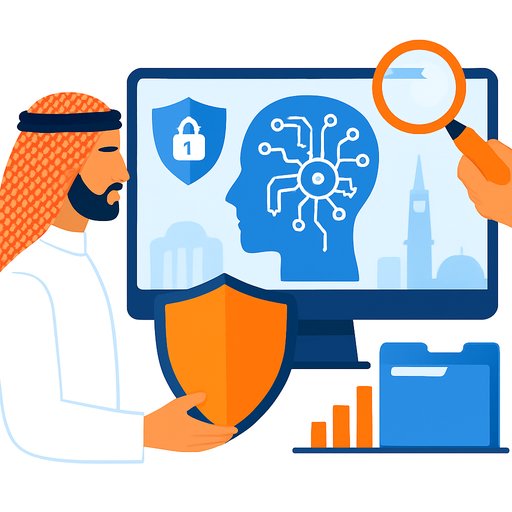Saudi boardrooms shift from crisis response to proactive risk management
As Vision 2030 compresses decades of progress into a single decade, Saudi organizations face a new class of forensic risk. AI-driven attacks, third-party exposure, and tighter regulation are testing governance at scale. The upside is clear, but so is the attack surface.
Leaders are moving from damage control to early detection. Forensics is no longer a back-office function; it's becoming a frontline capability embedded in procurement, finance, cyber, and compliance.
Why this matters now
AI is changing both business execution and criminal tactics. According to PwC's Digital Trust Insights: Middle East 2025, 70 percent of regional executives believe GenAI has increased cyber risk exposure, versus 55 percent globally. That delta signals higher stakes for Saudi firms as digital adoption accelerates.
Scale adds friction. PwC's Capital Projects and Infrastructure Survey 2025 (Middle East) reports that 63 percent of executives saw cost overruns or delays tied to governance and procurement weaknesses. Globally, 46 percent of organizations experienced fraud, corruption, or economic crime in the past two years, mirroring regional trends.
Regulatory momentum is reshaping expectations
With billions flowing into giga-projects and fintech, regulators are raising the bar. Nazaha's national anti-fraud drive, SAMA's tighter financial fraud and cyber controls, CMA's stronger governance and disclosures, and the new data protection law are setting a higher standard for conduct and evidence handling.
Compliance is getting harder and more technical. In PwC's Global Compliance Survey 2025, 85 percent of executives said requirements have grown more complex, and 82 percent plan to invest in technology to automate compliance. This is the moment to operationalize forensic readiness, not treat it as a checkbox.
Saudi Vision 2030 and Nazaha provide the context and direction for this shift.
What experts are seeing on the ground
"The forensic landscape in the Middle East is evolving at a formidable pace," said Rana Shasha'a, PwC Middle East Forensic Leader. "The sheer scale of investment in megaprojects and infrastructure programs brings exposure to procurement fraud, conflicts of interest, and delivery risks."
She added, "AI is augmenting business capabilities at an incredible pace, but the same technology is being weaponized by cybercriminals. We're now seeing scalable, hyper-personalized attacks - from GenAI-powered phishing to identity theft and disinformation campaigns."
Sector exposure is uneven
Financial services and fintech face rising GenAI-enabled fraud and cyber threats. Energy and infrastructure carry higher procurement and contractor risks due to volume, velocity, and vendor depth. Family businesses, central to regional economies, often have less formal governance and heavier related-party activity - a setup that enables blind spots if transparency is weak.
Across sectors, reputational risk is the constant. One breach can escalate into a trust crisis and trigger regulatory scrutiny, financing delays, and lost deals.
The new forensic toolbox
AI is amplifying detection speed and precision. Forensic teams now use anomaly detection to scan millions of records in hours, uncovering patterns that previously went unnoticed. Investigations are aided by AI-driven malware analysis and GenAI-powered forensic chatbots that surface linked entities, transactions, and behaviors.
"AI can connect far more data points than any human team," Shasha'a said. "It's enabling faster action, sharper prevention, and more resilient risk management."
From reactive to proactive: what changes inside the company
- Embed forensic controls in procurement: pre-award vetting, beneficial ownership checks, price-variance analysis, and conflict-of-interest attestations.
- Continuously monitor contracts and spend: anomaly flags on change orders, milestones, and unit-rate shifts.
- Strengthen cyber basics: MFA everywhere, privileged-access control, data loss prevention, and threat-intel tied to incident response.
- Tighten third-party oversight: risk-based onboarding, data-sharing limits, security clauses, and right-to-audit.
- Operationalize PDPL: data mapping, lawful basis tracking, retention and evidence handling, breach playbooks, and vendor DPAs.
- Build board-level visibility: risk dashboards, control testing cadences, and trigger-based escalation.
- Invest for automation: case management, e-discovery, workflow, and analytics integrated with ERP and SIEM.
Did you know?
- AI can analyze millions of records in hours, uncovering fraud schemes previously undetectable.
- Family businesses remain particularly vulnerable due to less formal governance and related-party transactions.
- Forensics is now embedded in governance, shifting from reactive response to proactive risk management.
An executive playbook for the next 90 days
- Run a forensic readiness assessment across procurement, finance, cyber, and legal; close the highest-impact gaps first.
- Stand up continuous monitoring for high-risk spend categories and critical suppliers; report exceptions to an independent risk committee.
- Test your incident-to-board pipeline: who gets alerted, how fast, and with what evidence.
- Map personal data under PDPL and update retention rules; rehearse breach and disclosure steps.
- Pilot one AI-driven detection use case (e.g., duplicate invoicing or payroll anomalies) and measure ROI.
- Align incentives: tie executive and project-lead KPIs to control effectiveness and timely issue remediation.
Culture, then tooling
This is as much a leadership decision as it is a technology choice. Prevention is cheaper than remediation, and regulators are reinforcing that logic with stricter disclosure and resilience requirements. The organizations that win will treat forensics as part of how they operate, not as a service they call after a breach.
"The future of forensics in the Middle East will be defined by scale, sophistication, and integration," Shasha'a concluded. "Forensics will no longer be a separate response function; it will be built into governance, compliance, and transformation programs as a frontline defense."
Level up your team
If your leadership bench needs practical AI skills for risk, compliance, or cyber, explore curated executive learning paths and certifications that compress time to value. Start here: AI courses by job and popular AI certifications.
Your membership also unlocks:






